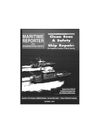
Page 48: of Maritime Reporter Magazine (October 1995)
Read this page in Pdf, Flash or Html5 edition of October 1995 Maritime Reporter Magazine
SHIP REPAIR UPDATE already owns one of the industry's largest facilities, with a 1,230-ft. x 246-ft. (375-m x 75-m) graving dock for vessels up to 500,000 dwt and two floating docks, 826.7 ft. x 147.6 ft. (252 m x 45 m) and 774.7 ft x 134.5 ft. (227 m x 41 m), with lifting capacities of33,000 tons and 30,000 tons, respectively. There are plans for a second graving dock at a cost of $120 million, assuming favorable financial resources and market con- ditions.
The yard reported that the num- ber of ships repaired in the first five months of this year rose 16 percent on comparable 1994 figures to total 55. Operating income was also up with a 13 percent increase to $28 million. Meanwhile, Dubai Dry- docks, with three graving docks ca- pable of handling large tankers, leads the Middle East in this trade.
During the latter part of last year
Dubai Drydocks inaugurated its new 40,000-dwt capacity floating dock, which allowed the yard to enter the smaller market available in the Ara- bian Gulf. Apart from Singapore and the Middle East, others through- out the world have been involved in expansion programs, namely: Hong
Kong United's (HUD) new floating dock, now fully operational, which was built in Singapore by Far East
Levingston, part of the Keppel
Group; the panamax capacity float- ing dock — which was purchased by
Bergen's Mjellam & Karlsen (M&K),
Norway, during 1994 — docked its firstvesselin June 1995. Two former naval yards in the U.S., located in
Philadelphia and Charleston, are currently being put under the privatization hammer, with the intention of attracting European bidders with desire to branch into the U.S. commercial repair (or even newbuilding) market.
This is all in addition to various new yards becoming operational and old yards re-opening over the past two years. These include: Thailand's
Unithai, which is now virtually fully operational; Keppel's re-opening of
Subic Bay Shipyard in the Philip- pines, and Cairncross Dockyard in
Australia; Greece's Neorion Ship- yard re-opening, A&P Appledore's lease of the former Neptune yard, which was once part of Swan Hunter;
Wear Dockyard Group's takeover of the lease on the Hebburn Dry Dock, also once part of Swan Hunter;
Coastline Industries' purchase of the three former Cammell Laird drydocks in Birkenhead; the
Antwerp Shiprepairers re-opening; a management buyout at Cantieri
Mediterraneo, Naples; new opera- tors for the drydocks at Genoa;
Vancouver Shipyard's return to op- eration of the large dock at Victoria,
British Columbia; and Hong Kong's
Yiu Lian Dockyard transfer of one of its floating docks to its new ship- yard at Shekau, part of mainland
China. The Mediterranean area is also one of re-organization. Portu- gal is about to lose its largest repair yard, Lisnave's Lisbon shipyard, with repair activities to be central- ized at the company's Mitrena yard in Setubal. The future for some of the Spanish yards may lie down the path of privatization, although the problems faced by both Greece and
Italy over privatization problems have been many, and therefore may not be a good solution for the Span- ish industry. One of the main prob- lems faced by both northern and southern Europe is the emergence of former naval yards in eastern
Europe, both in the Baltic and
Balkan states, onto the commercial market. This particularly applies to steelworking yards, where prices are below those of other European nations. Within northern Europe, the ferry refit market is about to become one of the most lucrative.
The recent Estonia disaster in the
Baltic Sea, the worst in European ferry and maritime operation, has again highlighted the problems of
RoRo passenger/car ferries.
The main design fault of such ships is very clear. Designed like a large box, the main car deck, if pen- etrated by seawater, will swiftly fill up and cause the ship first to roll over, and then, inevitably, to sink.
This disaster prompted the various authoritative organizations to re- think safety requirements onboard such ships and it will be to the repair industry that the ferry own- ers will turn to implement such de- sign changes.
Pressure on the shipowners' standards by classification societies and other legislative organizations have pre- cipitated an increase in the number of repair contracts available throughout this year
Rr filtration, protection, and endurance, nothing holds up better in rough water than Luber-finer. Every filter is factory-tested to ensure the highest performance under pressure. And with one of the broadest application lines, it doesn't matter what your boat is.. .if it floats, we make a filter to fit it. Luber-finer. Filters made to tough it out. 50
Circle 257 on Reader Service Card Maritime Reporter/Engineering News

 47
47

 49
49
